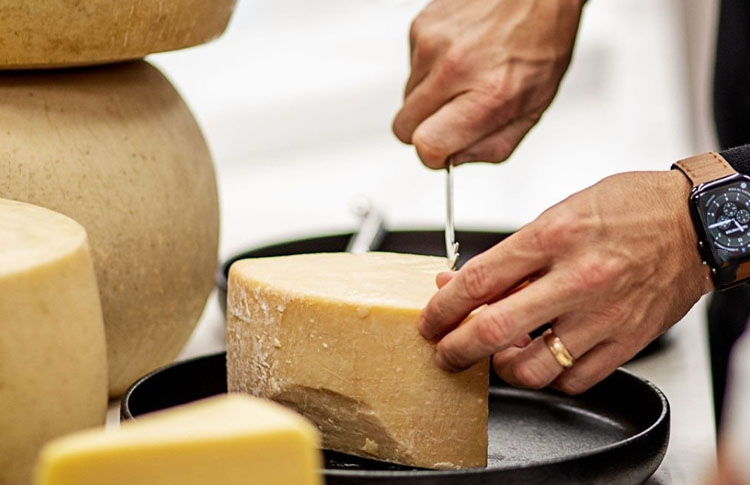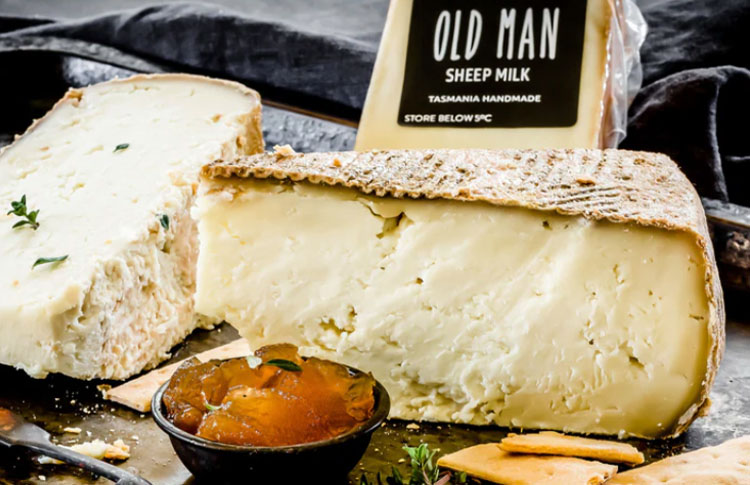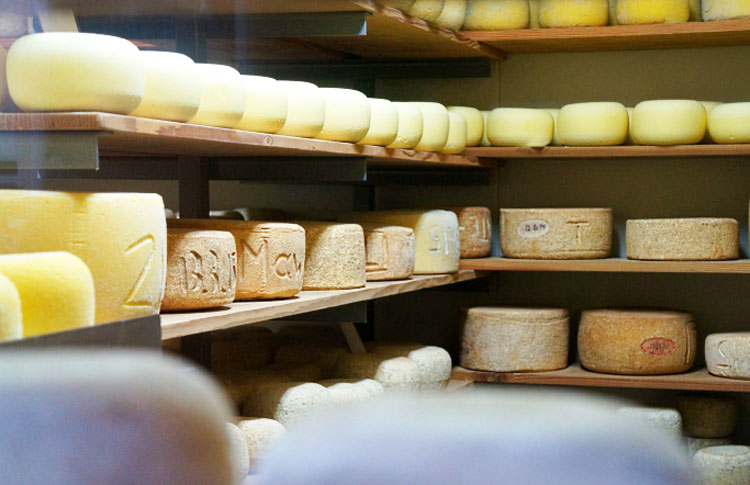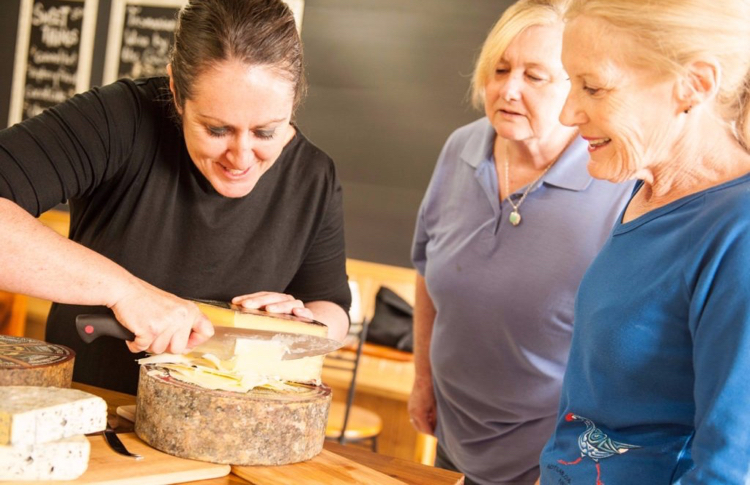
Cheesemaking has been around in Tasmania as long as it has anywhere in Australia – and judging by these great artisan cheese producers around Tassie, it ain’t going anywhere any time soon

Contents
Tasmania is Australia’s oldest cheese-making state, and there’s plenty of cheesey heritage and history here. However, it’s not only about the past, with many local, artisan cheesemakers pushing the boundaries on what to expect from Tasmanian cheese. If you love cheese and are heading to Tasmania, then read on for a full rundown on what to expect from Tasmanian cheese.
Read on to find everything you need to know about Tasmanian cheese. And of course, be sure to put tasting these great Tasmanian cheeses on your next Tasmanian itinerary!
Background: An Introduction to Tasmanian cheese
Cheesemaking in Australia is a distinctly European tradition, introduced with the first colonists' arrival. Generally speaking, Tasmania’s temperate climate, ample rainfall and rich soils are more similar to the northern European environments and landscapes from which many of those early settlers came. Therefore, Tasmania seems a natural fit for the food and farming traditions brought across by those early colonists. It makes sense, then, that a dairy industry soon boomed here and that Tasmania became the site of Australia’s first ever cheese factory: set up by the Van Diemen’s Land Company in 1820.
Two centuries on, the name of the island has changed, and the factory has closed. However, Tasmania’s rich dairy and cheesemaking heritage has not gone anywhere
Where is cheese made in Tasmania?
Traditionally, the main dairying areas of Tasmania are in the north – especially the Far North West (including King Island) and the Central North regions. Regions such as Circular Head (northwest), the Meander Valley (Central North), and Dorset (northeast) are particularly renowned for being real “Cow Country”. As such, it makes sense that lots of Tasmanian cheeses are made in these areas, or nearby.
However, both artisan cheesemakers and big industrial cheese companies can actually be found all around Tasmania: from the Central Plateau across to the East Coast and down to Bruny Island, south of Hobart.
What types of cheese are made in Tasmania?
How long is a piece of string? The answer for how many different types of cheese are made in Tasmania is about the same.
Given the history and (British colonial) background of the Tasmanian cheese industry, this has traditionally been cheddar country. However, there are also producers here with a long-standing reputation for everything from raclette and triple-cream brie to sheep’s cheese, and also one of Australia’s first officially certified raw-milk cheeses.
In recent years, the possibilities of taste combinations and different Tasmanian cheese types have become endless: blue vein, fresh ricotta, and even wild-wasabi and whisky-infused cheeses have become standards!

Where can you taste the best cheeses in Tasmania?
If you’re looking to taste the actual stuff, then make a point of putting these fantastic Tasmanian cheesemakers and cheese-tasting locations on your itinerary:
Hobart and the Coal River Valley
Wicked Cheese 1238 Richmond Road, Richmond
Ashley McCoy earned her cheese-making chops at the esteemed King Island Dairy, but wanted to go her own way and so set up Wicked Cheese, just outside Richmond in the Coal River Valley. The range of cheeses on offer here shows why she wanted to break free and break the mould a bit. She has some outstanding, innovative aged cheddars, like the slightly spicy, native Tasmanian pepperberry-infused version, or the Tasmanian single malt whisky-infused cheddar, a smooth-tasting cheese with a malty warmth, smokey overtones and a touch of sweetness. Wicked also makes superb mozzarella (fresh or smoked), a number of rich camemberts and bries, some relatively “wicked” waxed blue and blue-vein varieties, and a few nutty, bitey goats cheeses. You can visit the factory for complimentary tastings every day between 10am-4:30pm.
Coal River Farm 634 Richmond Road, Cambridge
Only a 20-minute drive from Hobart CBD, Coal River Farm offers a great day out for families and cheese-lovers alike. The farm was set up by corporate city refugees Melanie and Daniel Leesong, and they have gone all-in on producing quality handmade cheese by getting renowned Australian cheesemaker Tim Gadischke on board to lead their handmade cheese production. Taste their wonderful ashed brie or pine-ashed log for a French-inspired richness, while staying mild on bite, or go all-in on pungency with their delicious, umami-laden washed-rind cheese. You can see it all being made (along with chocolate and other produce) on a visit to the farm, which is open 9am-5pm everyday. It’s located in the middle of Coal River Valley, roughly halfway between Richmond and Cambridge.
Southern Tasmania and Bruny Island
Grandvewe Cheeses 59 Devlyns Road, Birchs Bay
Doing things a bit differently in many regards, Grandvewe are Australia’s only certified organic sheep dairy, making cheese from their own flock as well as sheep-whey gin and whisky at “Australia’s smallest distillery”. Anybody who thinks sheep’s cheese can be pretty one-dimensional will be made to think again here: Grandvewe’s impressive range runs from a soft white-mould Toto and nutty, gouda-like Old Man through to a tangy-crumbly Sapphire Blue and the aptly named, red wine-coated, well aged, and Italian toma-like Drunken Admiral. They even make a palate-refreshing Gin Herbalist cheese with leftover botanicals from their gin making. Grandvewe has cheese-making demonstrations, wine and cheese tastings, a “cellar door” and a full cafe-restaurant on site, open 11am-4pm. Not to mention gorgeous views over the D'Entrecasteaux Channel towards Bruny Island.
Bruny Island Cheese Company 1807 Bruny Island Main Road, Great Bay
Head cheese maker Nick Haddow spent a decade learning his craft around the world, then figured out that the best way to make authentic, traditional, but distinctively Tasmanian cheese was by starting a dairy farm. So he did, in 2017. Bruny Island Cheese Co. was one of Australia’s first certified raw-milk cheese producers, and they now make cheese from their own herd of organically raised dairy cows (which come from three old heritage breeds considered ‘not commercially viable’ by industrial dairy farmers). The name can be a tad misleading, as the cellar door location on Bruny Island is actually home to their brewery, while the cows are milked and cheese made on their dairy farm in the Huon Valley. Still, it’s a great spot to kick back with a beer and/or taste some delicious, raw-milk cheeses!

Devonport, Launceston and the North Coast
Ashgrove Cheese 6173 Bass Highway, Elizabeth Town
Situated just 25 minutes from the Spirit of Tasmania ferry terminal at Devonport, this dairy farm and artisan cheese producer is a must-stop shop for any cheese lovers arriving to Tasmania by the ferry from Melbourne. It’s also great for kids. In fact, in terms of visitor experience, this may be the best cheesemaker to visit in Tasmania. Ashgrove’s “Dairy Door” boasts a brand-new visitor centre, replete with glass viewing windows where you can watch the cheesemakers in action. Ashgrove are particularly well known for their “flavoured” cheeses (especially using local wasabi), but there’s a huge range. You can taste these many award-winning cheeses, paired with local wines if you like, at the Dairy Door. There's also house-made gelato, butter, cream, and a huge menu covering everything from smashed pea guacamole breakfasts and pumpkin quinoa salads to beer tasting paddles and a number of famously generous platters. It’s also, of course, a working farm, and you can head outside to see the cows grazing and watch the process from start to finish.
Heidi Farm Outside Burnie
Unfortunately, this specialist cheesemaker is not open to the public. But in case you were curious, this is where all (or a fair chunk of) that Tasmanian Raclette, Gruyere and Emmental comes from. Started by Swiss cheesemaker Frank Marchand in the 1980s, Heidi have continued making traditional Swiss cheeses using local milk from neighbouring farms. You can find it at several shops around Tassie (including those listed at the bottom of this post).

East Coast
Pyengana Dairy Company 163 St Columbia Falls Road, Pyengana
This is a lovely farm to visit, with an on-site cafe that is an ideal spot to park up and watch the cows roam freely in the paddocks against rolling hills and eucalyptus trees. Pyengana Dairy have been making cheese here for over 130 years, and they specialise in traditional, cloth-covered, matured cheddars. These have a lot more richness, bite and depth than your average Tasmanian cheddar. Plenty of awards have come their way as a result, and you can see the cheeses maturing in cellars directly below the cafe. You can also observe the cheesemaking process when they’re doing it (September-May, weekdays 9am-2pm), although the Farmgate Cafe is open 7 days (10am-5pm) for platters and tastings.
Bay of Fires Cheese Tasman Highway, St Helens
Another traditional cloth-bound cheddar specialist, Bay of Fires has a cheesemaking pedigree behind them that can match even Pyengana’s: it was started by a thirteenth-generation cheesemaker, originally from England, in 2009. Since then, it has won Best Cheddar at the Australian Grand Dairy Competition multiple times and is definitely worth a stop on any Tasmanian cheese itinerary. The farm herd is relatively small and spends all year grazing outside on lush pastures. There’s no official Dairy Door at the farm, but if you call ahead Ian and Tracy don’t seem to mind visitors dropping in for a taste and a look around.
Far North West
King Island Dairy 869 North Road, Loorana, King Island
Built off the format of a century of local co-operative dairy-making (primarily butter until the 1980s), King Island Dairy uses only fresh milk from local, on-island dairy farms to make an impressive range of specialty cheeses. You can wax lyrical about the island’s unique location and climate – being separated from the rest of Tasmania in Bass Strait, King Island receives regular enough rainfall to make it one of the few places in Australia where cows can easily graze outside year-round – but the proof of the pudding is in the eating. King Island are particularly well-known for their rich, full-fat, triple-cream brie and other white-mould cheeses. But they also have one of Tasmania’s best ranges of blue cheeses, from a slightly sweet, gorgonzola-style Endeavour through a rounded ash-blue brie to the sharp Roaring Forties blue. It’s certainly a bit harder to get to on your Tasmanian road trip, but the cheese shop (check seasonal opening times, but currently Monday, Wednesday, Friday and Sunday 11am-4pm) is certainly worth a tasting stop if you do.
Red Cow Organics 249 Lowries Road, Oldina
This wonderful local farm and cheesemaker isn’t open to the public. However, you can find Red Cow’s range of certified organic cheeses – from Persian feta to Swiss gruyere and a rich, creamy brie – at a number of stores around Tasmania (including some of those listed below).
Cheese shops and suppliers in Tasmania
If you can’t make it to the farm or dairy, don’t worry. These great shops stock a lot of Tasmania’s best artisan cheeses, too:
- Wursthaus Kitchen (Hobart)
- Salamanca Fresh (Huonville, Hobart)
- Salamanca Market (Hobart)
- Hill Street Grocer (Devonport, Hobart)
- Alps & Amici (Launceston)
- Harvest Market (Launceston)
Ready to go?
Whether you want to make visiting these cheesemakers the main purpose of your trip, or simply want to include them along the way while exploring the rest of Tasmania, First Light Travel can help you put together a personalised Tasmanian tour itinerary. Head to their Tasmania blog to find articles on all sorts of topics you might need. If you’re ready to start booking, you can check out their selection of self-drive Tasmania travel itineraries, or get in touch with them to help you personalise your own.
Recent Posts
Blog Categories
Blog archives
- March 2025 (1)
- November 2024 (1)
- October 2024 (1)
- September 2024 (8)
- June 2024 (4)
- May 2024 (2)
- April 2024 (2)
- March 2024 (13)
- February 2024 (3)
- January 2024 (5)
- December 2023 (6)
- November 2023 (4)
- October 2023 (11)
- September 2023 (2)
- August 2023 (6)
- July 2023 (2)
- June 2023 (17)
- May 2023 (3)
- April 2023 (5)
- March 2023 (8)
- February 2023 (9)
- January 2023 (12)
- December 2022 (9)
- November 2022 (12)
- October 2022 (12)
- September 2022 (12)
- August 2022 (6)
- July 2022 (9)
- June 2022 (7)
- May 2022 (3)
- April 2022 (4)
- March 2022 (6)
- February 2022 (1)
- January 2022 (4)
- December 2021 (2)
- November 2021 (3)
- October 2021 (1)
- September 2021 (4)
- August 2021 (10)
- July 2021 (13)
- June 2021 (6)
- April 2021 (2)
- March 2021 (2)
- February 2021 (1)
- January 2021 (1)
- December 2020 (2)
- November 2020 (3)
- October 2020 (2)
- September 2020 (1)
- August 2020 (1)
- July 2020 (1)
- June 2020 (1)
- May 2020 (1)
- March 2020 (1)
- February 2020 (2)
- January 2020 (4)
- December 2019 (2)
- November 2019 (1)
- October 2019 (1)
- September 2019 (5)
- August 2019 (1)
- July 2019 (5)
- June 2019 (1)
- May 2019 (1)
- April 2019 (1)
- March 2019 (1)
- February 2019 (1)
- January 2019 (1)
- December 2018 (1)
- October 2018 (1)
- May 2018 (1)
- February 2018 (1)
- December 2017 (1)
- October 2017 (1)
- June 2017 (1)
- May 2017 (1)
- February 2017 (1)
- January 2017 (1)
- September 2016 (1)
- August 2016 (2)
- July 2016 (1)
- June 2016 (1)
- May 2016 (1)
- April 2016 (1)
- December 2015 (1)




